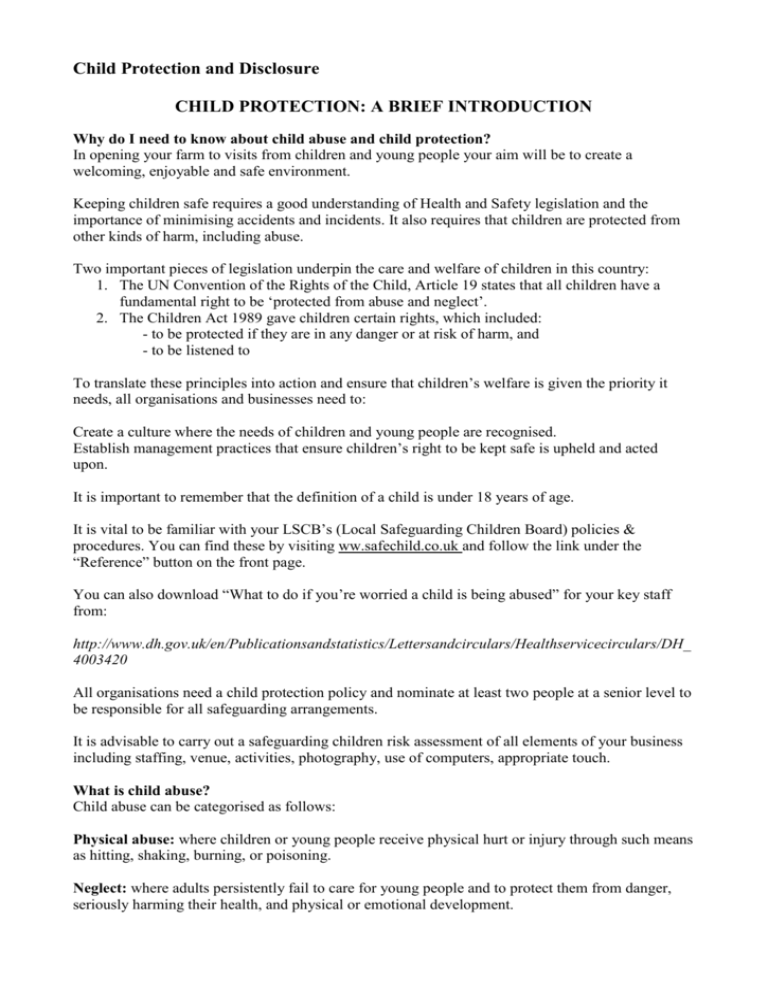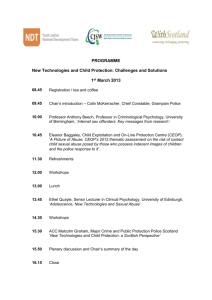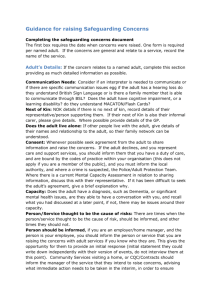Disclosure
advertisement

Child Protection and Disclosure CHILD PROTECTION: A BRIEF INTRODUCTION Why do I need to know about child abuse and child protection? In opening your farm to visits from children and young people your aim will be to create a welcoming, enjoyable and safe environment. Keeping children safe requires a good understanding of Health and Safety legislation and the importance of minimising accidents and incidents. It also requires that children are protected from other kinds of harm, including abuse. Two important pieces of legislation underpin the care and welfare of children in this country: 1. The UN Convention of the Rights of the Child, Article 19 states that all children have a fundamental right to be ‘protected from abuse and neglect’. 2. The Children Act 1989 gave children certain rights, which included: - to be protected if they are in any danger or at risk of harm, and - to be listened to To translate these principles into action and ensure that children’s welfare is given the priority it needs, all organisations and businesses need to: Create a culture where the needs of children and young people are recognised. Establish management practices that ensure children’s right to be kept safe is upheld and acted upon. It is important to remember that the definition of a child is under 18 years of age. It is vital to be familiar with your LSCB’s (Local Safeguarding Children Board) policies & procedures. You can find these by visiting ww.safechild.co.uk and follow the link under the “Reference” button on the front page. You can also download “What to do if you’re worried a child is being abused” for your key staff from: http://www.dh.gov.uk/en/Publicationsandstatistics/Lettersandcirculars/Healthservicecirculars/DH_ 4003420 All organisations need a child protection policy and nominate at least two people at a senior level to be responsible for all safeguarding arrangements. It is advisable to carry out a safeguarding children risk assessment of all elements of your business including staffing, venue, activities, photography, use of computers, appropriate touch. What is child abuse? Child abuse can be categorised as follows: Physical abuse: where children or young people receive physical hurt or injury through such means as hitting, shaking, burning, or poisoning. Neglect: where adults persistently fail to care for young people and to protect them from danger, seriously harming their health, and physical or emotional development. Emotional abuse: where children and young people are harmed by persistent emotional illtreatment which causes severe adverse effects on the child’s feelings of self worth, or where they are intimidated by threats or taunts. This may include witnessing the ill treatment of another or bullying. Sexual abuse: where young people are encouraged, or forced, to observe, or participate in, any form of sexual activity by adults or other children; either contact on non contact. This also involves abuse using modern technology including the Internet. Children can also be abusers. Despite the impression often given by the media, most child abusers are family members, relatives and other individuals who know a child well. However there are unfortunately a small number of individuals who seek opportunities to make contact with and target children and young people for the purpose of abusing them. How can I help to protect the children and young people visiting my farm? One of the most important measures you can take is to ensure that the risk of a child or young person being abused while on your premises is minimised. Rigorous selection of employees, volunteers and anyone over the age of 16 (including relatives) who will come into contact with children and young people is vital. Abusers are known to target organisations that are perceived to have lax procedures. Younger people who may be on work experience should be supervised at all times. This means: o When advertising, include a commitment to safeguarding statement on all adverts, making it clear that appointment is subject to a satisfactory CRB check. o Ensure an application form is filled in, including a Rehabilitation of Offenders statement. o Ensuring that enhanced CRB checks are completed on all individuals who may come into contact with children and young people- including an enhanced check on anyone who will have unsupervised access to children. (From 2010 staff will need ISA (Independent Safeguarding Authority) numbers. o Taking up and checking references from the most recent employer and another thoroughly. State clearly that the post involves work with children. o Ask for original proof of any relevant qualifications. o Interviewing. o Establish a robust and clear probationary and supervision system, and clear expectations of standards. o Establishing a culture in which everyone is open to discussing concerns and observations. People who abuse children thrive on silence and depend on loyalty from colleagues. o Being prepared to ‘think the unthinkable’ and to act on suspicions. Abusers don’t have two heads: they look like everyone else! o Planning activities involving children carefully with a view to minimising harm o Closely supervising employees, volunteers and all others having contact with children. What other measures can I take? You can devise a Code of Conduct that everyone having contact with children will be expected to adhere to; this would include advice on appropriate behaviour in relation to children. The following is taken from The National Trusts Code of Conduct as an example, and could be adapted for your purposes: Supervision Do: o arrange for an appropriate number of adults to be present, bearing in mind the activity, number, ages and any special needs of the young people o use more adults than recommended if the activity involves very young children or young people with learning or mobility difficulties o have male and female helpers where practical o try to ensure that at least one other colleague or a parent/teacher/leader will be around to help you (although this is not always possible) If you are likely to be on your own Do: o avoid being left alone with young people if possible, particularly one-to-one contact o e.g. lone car journeys, even short ones, with a young person are best avoided; unless it is an emergency. Get parental approval before taking someone home o use your common sense and take great care if you are left alone with young people o e.g. dont escort a single young child to the toilet; offer to stay with the rest of the class while the teacher does so If one-to-one contact is unavoidable Do: o make sure it is for as short a time as possible o ensure you are accessible to others o tell someone else where you are going, what you are doing and why (Safe and Sound -National Trust 2003) What should I do in the event of a suspected child protection matter? Everyone who has contact with children and young people needs to know what steps to take in the event of a suspected child protection matter. You must ensure that all employees, volunteers or others having contact with children know exactly what to do. A child protection concern may arise in the following ways: o From a direct observation of an incident, a suspicious injury, or bruising on a child. o From something a child says. If the child is in immediate danger steps must be taken to secure the child’s safety. Depending on the circumstances this could include contacting 999 for an ambulance or the police, if a crime has or may be committed, or the child is in imminent danger as well as contacting the local children’s social care services As soon as possible after the incident the person involved must write down as fully as possible what they did, what they saw and what they were told. All recordings must be factual and should not include opinions or assumptions, since this recording might need to be used as evidence in court, and will be seen by all interested parties. Date, time and sign. These records will be passed to either children’s social care services or the police. In the interim, store them in a secure place. Everyone may “whistleblow”. Children sometimes choose to share something that has happened to them with an adult they perceive as trustworthy. Should this be the case there are some important ‘do’s and don’ts’. Do: o o o o o o Listen carefully and try to remember exactly what was said. Give reassurance that you are taking the child seriously. Let the child know that you will be telling someone. Keep calm, and try not to express shock, even if the information is shocking. As soon as possible afterwards write down as exactly as possible what was said. Use the child’s words in your recording - not your interpretation of what was said. Do not: o Promise to keep secrets. o Say you don’t or can’t believe them. o Ask leading questions and put words in the child’s mouth. o Push for more information than the child wants to give. What action do I take in the event of an allegation or suspicion of child abuse? All suspicions or allegations of child abuse need to be reported to the authorities to be investigated. Child Protection investigations can only be undertaken by authorised individuals employed by children’s social care services or the police. As soon as possible after directly observing or hearing about a concern from an employee/volunteer you must inform either your local children’s social care services or the police. You should make sure you have the relevant phone numbers in an easily accessible place. Although child abuse issues tend to provoke strong emotions, assumptions of innocence or guilt must not be made by yourself or any other individual. Do not attempt to investigate the matter yourself. If uncertain, always contact children’s social care services for advice. Children’s social care services and the police will jointly conduct the investigation if a crime may have been committed. Anyone involved may be asked for information at a later date In some instances you may be required to give evidence if a case is brought to court, but many investigations do not proceed to a court hearing. Where appropriate the children’s social care services will keep you informed of progress, but the information you receive may be relatively limited owing to confidentiality. What should I do if allegations are made about an employee or volunteer or other person connected to the farm? Any referral about concerns about anyone who has a “duty of care” and/or works in a role with responsibility for children should be made without delay to the LADO (Lead Authority Designated Officer). His/her role is to oversee, advise and support the ensuing procedures. Refer to your LSCB website for details of procedures, timescales etc. Once an investigation is complete there may be insufficient evidence for a court of law but sufficient concerns remaining to consider terminating an individual’s contract. The LADO and police will advise you about this. It is important that confidentiality is maintained at all times, that information is only shared with those who need to know and that gossip is avoided. Key Principles of Child Protection: LISTEN TO CHILDREN BE VIGILANT THINK THE UNTHINKABLE REPORT CONCERNS WITHOUT DELAY RECORD CAREFULLY







